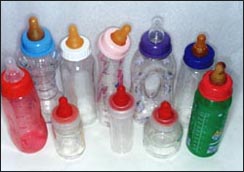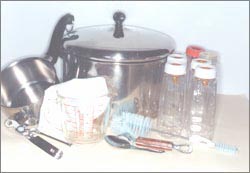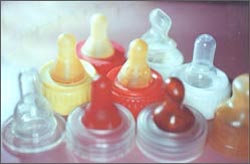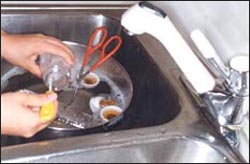



Copyright ⓒ 2014 John Sangwon Lee, MD., FAAP
Formula feeding to newborn infants 인공영양을 신생아에게 먹일 때

Different types of milk bottles
![]()

What you need to feed artificial nutrition


Different types of nipples


Preparation for feeding artificial nutrition

If for some reason the mother is unable to breastfeed the baby with her mother, or if the mother can breastfeed but the baby is unable to feed her mother’s breast, she must feed the baby her artificial nutrition instead of the mother’s breast milk.
The ingredients of artificial nutrition can be made almost the same as those of breast milk, but no matter how advanced science is, artificial nutrition will not be created in the same way as breast milk now or in the future.
Breast milk contains immune bodies, giant cells, and biochemical substances, but artificial nutrition does not contain any of them. Immune bodies or giant cells kill viruses, bacteria, and other pathogens to prevent breastfeeding babies from getting infectious diseases. Infant formula is often called powdered milk or milk, but it is wrong to call artificial nutritional formula or milk.
There are many types of artificial nutrition, such as artificial nutrition made using milk protein, artificial nutrition made using soy protein, and special artificial nutrition made using special proteins.
Namyang milk powder, daily milk powder, Enfamil, Similac, and carnation, which are commonly fed to newborns and infants these days, are artificial nutrition made using milk protein.
Everyday Soy A, Namyang Soi, Pro Soybi, and Isomil are artificial nutrition made using soy protein. In addition, daily HA, Neutramigen, Progestmeal, Alimentum, and carnation H are special artificial nutrition made with special proteins.
The name of artificial nutrition is different according to the name given by the artificial nutrition manufacturer. In addition, artificial nutrition manufacturers make various types of artificial nutrition.
Some are powdered artificial nutrition and some are liquid artificial nutrition.
There is also ready-to-feed liquid artificial nutrition, which allows you to open liquid artificial nutrition can and put the liquid artificial nutrition in a milk bottle and feed it directly to the baby.
There is also a concentrated liquid artificial nutrition that can be fed to a baby by diluting the concentration of the concentrated liquid artificial nutrition by adding a certain amount of water to the concentrated liquid artificial nutrition.
Ready-to-feed liquid artificial nutrition, which can be fed directly without dilution, is quite simple because it can be fed directly from a can to a baby according to a bottle, but the disadvantage is that it is expensive.
For powdered artificial nutrition, a certain amount of water must be added according to the instructions of the artificial nutrition manufacturer before feeding.
The value of powder artificial nutrition is much cheaper than that of ready-to-feed liquid artificial nutrition or concentrated liquid artificial nutrition.
Before feeding powder or concentrated artificial nutrients, add a certain amount of water to a certain amount of artificial nutrients according to the instructions and dilute the amount of water appropriately.
It may be contaminated with artificial nutrition, and feeding a baby with such contaminated artificial nutrition can cause the baby to develop gastroenteritis. Depending on the age, weight, and feeding characteristics, the amount of artificial nutrition that the baby eats once, the time it takes to eat once, and the feeding interval are different. In general, about 2 to 4 hours after birth, sterilized water or 15 to 30 ㏄ of 5% glucose is first fed. If there is no abnormality until 1~2 hours after eating the first food, give the first artificial nutrition about 15~30㏄. After that, if there is no abnormality, artificial nutrition is given every 2 to 4 hours.
Before feeding artificial nutrition, raise the bottle upside down and drop a drop or two of artificial nutrition on the back of the mother’s hand or wrist to see if the temperature of the artificial nutrition is suitable for eating.
The temperature of artificial nutrition that is most suitable for a baby to eat should be similar to the temperature of the mother’s milk or the same as the mother’s body temperature.
When a baby sucks the rubber pacifier from an artificial nutrition bottle, he swallows air with artificial nutrition and strength. The milk bottle should be tilted appropriately to avoid swallowing a lot of air.
If you can’t breathe well when feeding artificial nutrition, then take the rubber nipple out of your mouth for a while and put it back in. When feeding a baby with artificial nutrition, the baby should be comfortably embraced in the mother’s arms and fed with love in the same way as when breastfeeding.
For more information on artificial nutrition, refer to volume 5 Artificial Nutrition Milk Baby Food Vitamin Mineral Protein Carbohydrate Fat’ and also use the reference book there. Copyright ⓒ 2014 John Sangwon Lee, MD., FAAP
“부모도 반의사가 되어야 한다”-본 사이트의 내용은 여러분들의 의사로부터 얻은 정보와 진료를 대신할 수 없습니다.
“The information contained in this publication should not be used as a substitute for the medical care and advice of your doctor. There may be variations in treatment that your doctor may recommend based on individual facts and circumstances.
“Parental education is the best medicine.“